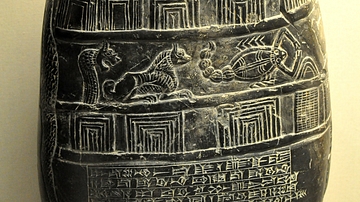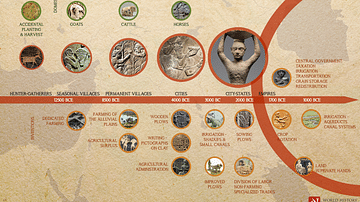Search
Search Results

Image
Boundary Stone from Mesopotamia
This boundary stone, or kudurru, records a gift of land made by Eanna-shum-iddina, governor of the Sea-Land in Southern Babylonia. The receiver's name is Gula-Eresh. The text ends with a series of curses on anyone questioning the gift or...

Image
God and Goddess from Mesopotamia
The upper halves of terracotta plaques, depicting a male figure (on the left, who has a long beard) and a female figure (on the right, with bare breast) wearing a horned headdress (symbol of divinity) and appearing to hold a long bar in both...

Image
Agriculture in the Fertile Crescent and Mesopotamia - Timeline
A visual timeline illustrating the evolution of agriculture in parallel with invention and social development in the region of the Fertile Crescent (a term first used in 1916 by Egyptologist J.H. Breasted), enabling the establishment of cities...

Definition
Ancient Syria
Syria is a country located in the Middle East on the shore of the Mediterranean Sea and bordered, from the north down to the west, by Turkey, Iraq, Jordan, Israel, and Lebanon. It is one of the oldest inhabited regions in the world with archaeological...

Video
Mesopotamia and the Fertile Crescent - A Short History
Mesopotamia is an ancient region in the Middle East, east of the Mediterranean by the Zagros mountains, between the two rivers Tigris and Euphrates. The name ‘Mesopotamia’ comes from the Greek meaning ‘between two rivers’. The region is now...

Video
Mesopotamia: Crash Course World History #3
In which John presents Mesopotamia, and the early civilizations that arose around the Fertile Crescent. Topics covered include the birth of territorial kingdoms, empires, Neo-Assyrian torture tactics, sacred marriages, ancient labor practices...

Video
A Short History of Sumer and the Sumerian Civilization from Mesopotamia
The Sumerians flourished in Mesopotamia between c. 4100 – 1750 BCE in the region of Sumer which was not a country, but a region made up of a number of walled city-states, each with its own king. The Sumerian civilization developed the first...

Video
Queen Kubaba of Mesopotamia: the Only Queen on the Sumerian King List
Queen Kubaba of Mesopotamia is known as the only queen who has been named on the Sumerian King List, which is unsurprisingly, a bit of a boy’s club. Kubaba is one of very few women who ruled Mesopotamia in her own right, and the surviving...

Video
What Languages Did People in Mesopotamia Speak?
A video about the languages spoken in ancient Mesopotamia.

Video
Scribes in Mesopotamia
Professor of Hittite and Anatolian Languages Theo van den Hout tells us about who scribes in Mesopotamia and Anatolia were. This video was made for the Oriental Institute Museum special exhibit "Visible Language: Inventions of Writing...